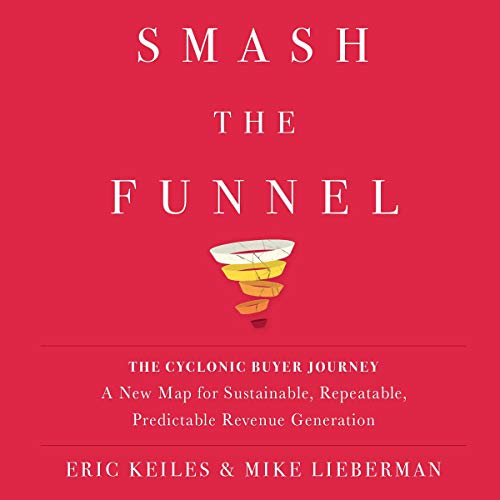
As a member of the Portland Chapter of Entrepreneurs’ Organization, I participate in a book club. This quarter’s book is “Smash the Funnel” by Eric Keiles and Mike Lieberman. For those not lucky enough to have a copy on hand, or lack the time to read the book before we discuss it as a group, I’ve put this book summary together. You’re welcome.
The traditional sales funnel is broken. In today’s world of empowered buyers with endless information at their fingertips, the linear sales process of simply identifying leads and nurturing them down the funnel is no longer effective. Buyers are circumventing the funnel entirely, with the typical B2B purchase decision now involving 6.8 people and happening 57% of the way through the buying process before salespeople even get involved. To adapt, sales teams must completely rethink their approach and “smash the funnel.”
The new model proposed by Keiles and Lieberman is called the Revenue Cloud™. Rather than mapping buyer journeys through a shaped funnel, it’s an interconnected mesh of people, processes, and technology that enables the fluid, multi-threaded experiences that modern buyers actually navigate. Within this mesh, sellers must master four key disciplines:
- Building a Maximally Valuated Prospect (MVP)
The new “lead” in the Revenue Cloud isn’t just an individual lead – it’s a Maximally Valuated Prospect comprised of multiple buyer stakeholders across the organization. The goal is to assemble this diverse MVP from the outset by mapping all potential players, understanding their unique perspectives/needs, and coordinating outreach to ultimately facilitate a “cloud of consensus.”
- Channeling Perpetual Insights
In the Revenue Cloud, customer insight gathering never stops – across the entire lifecycle from prospect to loyal customer. Smart sellers leverage data mining, social monitoring, and other tools to continuously channel fresh insights about each MVP’s evolving needs. They also share notes, record interactions, and enable full team visibility.
- Creating Sellingt™ Experiences
With buyers in control, sellers must trade product-pushing for curating bespoke “Sellingt” experiences aligned to the MVP’s specific context. From provocative thought leadership content and diagnostic tools to customized product trials and interactive workshops, Sellingt involves crafting tailored journeys of mutual value in partnership with the buyer.
- Negotiating for a Maximize™
Traditional “closing” the deal is replaced by a collaborative process of “negotiating to a Maximize.” The goal is to align both parties around a joint solution that maximizes results for each side based on their unique needs and desired outcomes. This transforms selling from a zero-sum game to a win-win value exchange.
Throughout, smart sellers leverage automation and augmented intelligence technologies like AI-powered analytics, conversational computing, and predictive modeling to gain a productivity edge across all disciplines.
Operationalizing the Revenue Cloud requires several organizational enablers:
Rethink the Sales Organization. Instead of siloed roles, the Revenue Cloud calls for creating cross-functional “pod” teams aligned to each MVP and tasked with orchestrating the full end-to-end Selling experience. Pods should be purpose-built with specialists across functions like sales, marketing, finance, product, and delivery based on each MVP’s needs.
Institute Fluid Processes & Tools. Supporting the MVP-centric, non-linear buyer journeys requires flexible processes that transcend fixed workstreams and handoffs. From how territories and compensation plans are designed to implement an agile tech stack, sales operations must inject more fluidity.
Cultivate New Skills & Mindsets. Traditional skill sets like consultative selling still apply, but Revenue Cloud sellers must augment them with competencies like journey mapping, experience design, data/tech savviness, storytelling, and commercial guidance to facilitate Selling experiences and Maximize negotiations.
Ultimately, while the old funnel concentrated value, the Revenue Cloud aims to proliferate it across the entire buyer-seller relationship. It’s a model founded on collaboration, continuous value creation, and mutual success rather than individual achievement.
For executives and sales leaders, the Revenue Cloud framework presents both an immense opportunity and a daunting change management test. Smashing the funnel mentality will require moving past individual heroics metrics, dismantling legacy silos and hierarchies, upskilling the talent pool, and empowering much more cross-functional teaming. Those who lead their organizations to successfully adapt, however, will be well-positioned to thrive and grow revenues in our increasingly formidable era of heightened buyer control.
The book provides a bold vision grounded in deep buyer research. While no simple recipe, Keiles and Lieberman offer a foundational playbook for the systemic shifts required for selling to remain viably effective in our digitally transformed age. Sales leaders would be wise to critically evaluate their readiness to embark on the prescribed journey of change. I highly recommend that growth-oriented sales professionals purchase a copy of this book for your library as you will be referencing it regularly.




